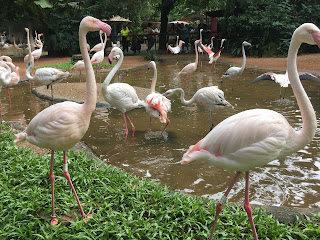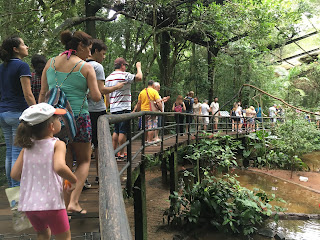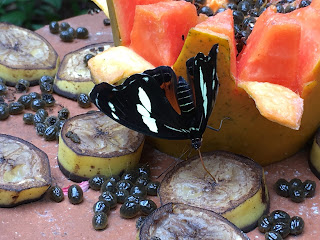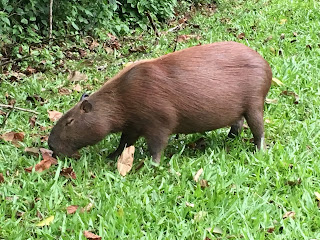BIRD PARK /
PARQUE DAS AVES
Obviously the main attraction here in Iguazu are the falls, but the Bird Park (Parque das Aves) is also a must visit place, if you have time. All you need is a couple of hours.
Most of the species of fauna and flora here are from the region or from tropical areas in Brazil.
First animal we saw in the Bird Park was actually not a bird, but a monkey. The saguis are typical monkeys from Brazil and can be found even in urban centres like in Rio. They are super small, in fact smaller than a rabbit.
I didn't get this guy's name, but I like his hair do.
Flamingos
My favourite.
SOURCE: http://www.parquedasaves.com.br/en/
Parque das Aves is an internationally recognised rescue and conservation centre for birds, located in the middle of the rich and exuberant Rainforest, neighbour of the Iguaçu National Park. It's an essential tour for those who visit Foz do Iguassu, where you'll experience a direct contact with more than 1320 birds from about 143 different species. There are 16.5 hectares of lush Atlantic Rainforest maintained to provide the best habitat for our animals.
Best travelling companions.
The fauna here is spectacular and makes you feel like you are wandering right in the forest. I love the colours and shapes of the flowers, although green plants and tress are predominant.
Banana tree.
SOURCE: http://www.parquedasaves.com.br/en/
50% of our birds have been rescued by the Environmental Police, Federal Police and by IBAMA (the Brazilian environment agency).
About 50% of our birds come from seizures made by the Environmental Police, Federal Police and by IBAMA. These animals are rescued from environments of mistreatment, trafficking and illegal possession; others come from Rehabilitation Centers and Sorting of Wild Animals. We have also received feeble birds who have suffered accidents and birds chicks that were delivered to the environmental organizations after falling from their nests.
Avi made a friend.
Bromelias
SOURCE: https://en.wikipedia.org/wiki/Bromeliaceae
Bromeliads are plants that are adapted to various climates. Foliage takes different shapes, from needle-thin to broad and flat, symmetrical to irregular, spiky to soft. The foliage, which usually grows in a rosette, is widely patterned and colored. Leaf colors range from maroon, through shades of green, to gold. Varieties may have leaves with red, yellow, white and cream variations. Others may be spotted with purple, red, or cream, while others have different colors on the tops and bottoms of the leaves.
SOURCE: http://www.parquedasaves.com.br/en/
Reptile Refuge
Did you know that birds are closely related to reptiles in evolutionary terms? So that you can learn a little more about this group, the Parque das Aves has put together a stimulating habitat where you can observe some of the amazing reptiles of Brazilian’s fauna, such as boas, iguanas, alligators and the fearsome Anaconda.
SOURCE: http://www.parquedasaves.com.br/en/
Aviary of River and Mangrove Birds
The Aviary of River and Mangrove Birds houses birds adapted to an aquatic environment, such as scarlet ibis and egrets, in addition to toucans, red-legged seriemas and many other species.
SOURCE: http://www.parquedasaves.com.br/en/
Macaw Aviary
In Brazil live many species of macaws and you can meet many of them here in the Parque das Aves. Immerse yourself in a dawn of colours created by several species of macaws and parrots in this walk-through aviary, in which you can feel very closely the presence of birds flying around you.
SOURCE: http://www.parquedasaves.com.br/en/
Kingdom of the Butterflies
Some cultures believe that when a butterfly lands on you, it’s a sign of good news. Come and be dazzled by this constant metamorphosis in a delicate and charming aviary, shared by numerous species of butterflies and hummingbirds that will change your life.
Papaya and bananas for breakfast.
SOURCE: http://www.parquedasaves.com.br/en/
Most of the birds that arrive are physically very frail: with clipped wings, beaks and limbs partially amputated, blind and unable to fly. These animals are usually not accepted by other zoos, since they need special care and hardly reproduce. They are often rejected by institutions, since their appearance is not considered appropriate for display. At Parque das Aves, they have access to treatment, shelter and care, even when they are not on display.
With humidex over 35 degrees, the girls had fun getting wet in the fake pond.
It was fun, until Fifi sliped and fell. She was fine and the moment was almost caught on this click.
IGUAZU NATIONAL PARK /
PARQUE NATIONAL DO IGUAÇU
Right beside the Parque das Aves is the Brazilian side of the falls. We basically choose the worst day to visit it: Good Friday! Since it's a holiday here in Brazil, the place was packed with tourists. Apparently the hotels are over 90% capacity and the line ups were gigantic.
We waited 2 hours and 20 minutes in line to get the park. Yes... TWO HOURS AND TWENTY MINUTES! But again, we picket the worst day to come.
The ticket costs R$36 for Brazilians (CAN$16) and R$62 (CAN$ 25) for foreigners, like Canadians. At the entrance, a bus picks you up and takes you into the park and you choose your stop. There are different trails, viewpoints, cafeterias and washrooms.
SOURCE: https://en.wikipedia.org/wiki/Iguaçu_National_Park
The area of the park open for visitation and where the concession areas of Cataratas do Iguaçú S/A are located, accounts for approximately 0.3% of the total area of the park.
The most spectacular sightseeing of the park is the Iguaçú Falls, which form a 2,700m wide semicircle, while the water falls from a height of 72m. The number of waterfalls ranges from 150 and 300 depending on the Iguaçú river flow. Besides the exuberant waterfalls, there are other attractions such as rich fauna, the Poço Preto (the Black Well), the Macuco Waterfall, the Visitors Center, the Santos Dumont Statue, a homage paid by VASP (a defunct airline company) to the "Father of Aviation", who lent all his prestige and efforts in turning the falls area into a National Park. The park received 1,550,700 visitors (2014)
Since we were starving from waiting in line for so long, we went straight to eat. The Porto Canoas Restaurant is located at the far end of the visitation area. We had a much needed all you can eat buffet dinner - naturally, more expensive that average places - over looking the falls. Great experience.
This alligator lives right underneath the restaurant. It's still a baby but knows it can easily get dinner here, from the restaurants clients - although it's prohibited to feed wild animals at the park.
A capybara encounter.
SOURCE: https://en.wikipedia.org/wiki/Capybara
The capybara is a mammal native to South America. It is the largest living rodent in the world. Its close relatives include guinea pigs and rock cavies, and it is more distantly related to the agouti, the chinchilla, and the coypu. The capybara inhabits savannasand dense forests and lives near bodies of water. It is a highly social species and can be found in groups as large as 100 individuals, but usually lives in groups of 10–20 individuals. The capybara is not a threatened species but is hunted for its meat and hide and also for grease from its thick fatty skin, which is used in the pharmaceutical trade
Watch out for these cute guys. The Quatis can get pretty aggressive when there is food involved. This one is even doing his tricks... trying to get a piece of chocolate someone was eating. No chance.
Socializing at the falls. We met an older couple from California. This is their second time here at the falls, and they love it.
We survived the extremely touristy day and it was all worth it. I am glad we saw the falls from the Brazil side, as well as from the Argentina side, because they are completely different experiences. In Brazil you get a more "clean" adventure. In Argentina the fun is to be right there, close to it. Both are great. We've covered all of it. Definitely a tour we recommend.










































No comments:
Post a Comment